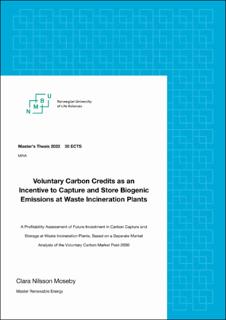| dc.contributor.advisor | Linnerud, Kristin | |
| dc.contributor.advisor | Rolén, Hanne | |
| dc.contributor.author | Moseby, Clara Nilsson | |
| dc.date.accessioned | 2022-09-09T08:44:16Z | |
| dc.date.available | 2022-09-09T08:44:16Z | |
| dc.date.issued | 2022 | |
| dc.identifier.uri | https://hdl.handle.net/11250/3016790 | |
| dc.description.abstract | To reach the goal of The Paris Agreement the transition to renewable energy and energy efficiency will be necessary, but insufficient to achieve the goal of 1,5 Degree Celsius. According to the UN’s Climate Panel and IEA, we will have to make greater use of removal projects and create negative emissions. The potential in the waste industry is great both for cutting emissions and creating negative emissions. Captured biogenic CO2 creates negative emissions and about 50 percent of the emissions from waste incineration plants are biogenic. Carbon Capture and Storage (CCS) requires significant investments and is currently unprofitable in the waste industry. However, captured biogenic CO2 qualifies for the sale of carbon credits on the Voluntary Carbon Market (VCM). The VCM is an immature and small market. As the situation is today, it is difficult for companies to know whether the sale of such credits can make an investment in carbon capture and storage profitable or not.
This thesis addresses the challenging of high costs and lack of incentives related to CCS at waste incinerations plants. I examine whether the sale of voluntary carbon credits can be a good enough incentive to make CCS of biogenic emissions profitable for waste incineration plants by 2030.
The main findings in the market analysis indicate that the VCM will grow in the years towards and after 2030, both in quantitates and prices. For a well-functioning VCM, integrity must be ensured in the marked. The most important factors to achieve this are: a heterogeneous market, avoided double counting, additionality, and a standard for verification.
I find that the sale of voluntary carbon credits from the biogenic emissions can lead to profitability in investing of CCS at waste incineration plants. This requires that the prices in the VCM are set high enough. Lower prices in the VCM can be accepted if waste incineration is included in the EU ETS. I observe that the project of CCS at waste incineration is most sensitive to changes in operation and maintenance cost, saved costs, carbon credit prices and the share of biogenic emissions in the waste mix. The sensitivity analyzes indicate that the project is quite robust to changes. | en_US |
| dc.description.abstract | For å nå målet i Parisavtalen vil overgangen til fornybar energi og energieffektivisering være nødvendig, men ikke tilstrekkelig for å nå målet om 1,5 grader celsius. Ifølge FNs klimapanel og IEA må vi i større grad benytte fjerningsprosjekter og skape negative utslipp. Potensialet i avfallsbransjen er stort både for å kutte utslipp og å skape negative utslipp. Fanget CO2 med biogent opprinnelse skaper negative utslipp og omtrent 50 prosent av utslippene fra avfallsforbrenning er biogene. Karbonfangst- og lagring (CCS) krever betydelige investeringer og er i dag ulønnsomt i avfallsindustrien. Fanget biogent CO2 kvalifiseres for salg av karbonkreditter på det frivillige karbonmarkedet (VCM). VCM er et umodent og lite marked. Slik situasjonen er i dag, er det vanskelig for bedrifter å vite om salg av slik kreditter kan gjøre investering i CCS lønnsomt eller ikke.
Denne oppgaven tar for seg utfordringen knyttet til høye kostnader og mangel på insentiver knyttet til CCS ved avfallsforbrenningsanlegg. Jeg undersøker om salg av frivillige karbonkreditter kan være et godt nok insentiv til å gjøre CCS av biogene utslipp lønnsomt for avfallsforbrenningsanlegg i 2030.
Hovedfunnene i markedsanalysen viser at VCM vil vokse i årene frem mot og etter 2030. For et velfungerende VCM kreves det integritet i markedet. De viktigste faktorene for å oppnå dette er: et heterogent marked, unngå dobbelttelling, addisjonalitet og en felles standard for verifisering.
Lønnsomhetsanalysene viser at salg av frivillige karbonkreditter fra de biogene utslippene kan føre til lønnsomhet ved investering i CCS ved avfallsforbrenningsanlegg. Dette krever at prisene i VCM settes høyt nok. Lavere priser i VCM kan aksepteres dersom avfallsforbrenning er inkludert i EU ETS. Jeg observerer at prosjektet er mest følsomt for endringer i drifts- og vedlikeholdskostnader, sparte kostnader, karbonkredittpriser og andelen biogene utslipp i avfallsblandingen. Sensitivitetsanalysene indikerer at prosjektet er ganske sterkt overfor endringer. | en_US |
| dc.language.iso | eng | en_US |
| dc.publisher | Norwegian University of Life Sciences, Ås | en_US |
| dc.rights | Attribution-NonCommercial-NoDerivatives 4.0 Internasjonal | * |
| dc.rights.uri | http://creativecommons.org/licenses/by-nc-nd/4.0/deed.no | * |
| dc.title | Voluntary carbon credits as an incentive to capture and store biogenic emissions at waste incineration plants : a profitability assessment of future investment in carbon capture and storage at waste incineration plants, based on a separate market analysis of the voluntary carbon market post-2030 | en_US |
| dc.type | Master thesis | en_US |
| dc.description.localcode | M-FORNY | en_US |

